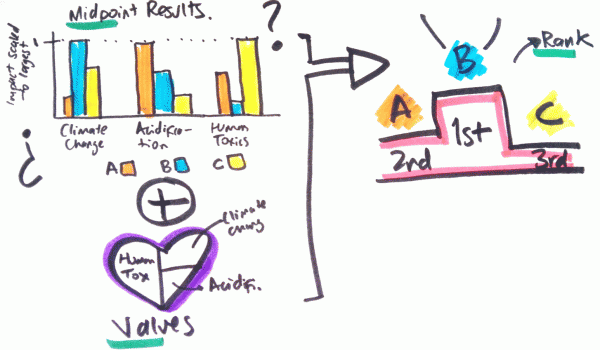An Alternative for Interpreting Comparative LCAs: Try Ranking the Results Using Multi-Attribute Analysis
We’re proud to share a new publication from EarthShift Global senior analyst Valentina Prado.

We’re proud to share a new publication from EarthShift Global senior analyst Valentina Prado: she and co-author Reinout Heijungs of the University of Amsterdam have just unveiled a method for ranking alternatives in a comparative LCA, named SMAA (stochastic multi-attribute analysis) in the journal Environmental Modelling and Software.
While SMAA has been used before, this is the first publication to offer a step-by-step explanation to make the method (which applies to comparative LCAs with quantified uncertainty) transparent and easier for others to apply. The publication includes an Excel tool which can be used to implement the approach starting from comparative results and will be of interest to LCA practitioners who want to get the most utility from their findings.
SMAA is especially useful in those cases when there is no clear best alternative. The goal of LCAs is support for decision-making, but when you have to reconcile trade-offs and differing priorities, how do you evaluate the overall score? SMAA helps you go from mid-point results to a ranking of the alternatives that reflects both performance and the values of decision makers. In other words, the ranking process can help you find the best and worst alternatives of a set.
SMAA aggregates comparative LCA results while fulfilling the following properties:

1) Limiting compensation,
2) Incorporating uncertainty into the LCA results, and,
3) Applying the whole weight space in the case of unknown preferences.
Compensation refers to the approach of allowing good performance in one area to offset poor performance in another for an indefinite period, in the same manner as economic profit and loss make up for one another.
In an environmental context, however, it doesn’t make sense to trade improvements in one area of the environment (profits) for degradation in other environmental aspects (loss) - at least not indefinitely. This outcome can occur when an LCA analysis uses full compensation, because a single strong performance can dominate the results.
Alternatively, aggregation can be done in a partially compensatory manner (as done in SMAA), where there is a limit of how much offsetting credit (or loss) an alternative can provide. These partially compensatory assessments offer a more balanced look at pros and cons and prevent a single performance indicator from overshadowing everything else.
SMAA aids the incorporation of uncertainty into an LCA by evaluating the mutual differences of alternatives with respect to the spread of the data. So, when uncertainty in one particular aspect is reduced (let’s say from better data), the mutual differences become more significant – and the more-certain aspect can play a more influential role in the assessment. This means that the aspects where we have the most knowledge and confidence get greater weight in guiding the decision.
Finally, the weights in SMAA are stochastic, or randomly determined, so that the whole possible space of weight factors is sampled. This also helps the final analysis reflect a range of possible outcomes, because results will reflect the likelihood for each alternative to occupy a certain rank – based on the given uncertainty in the performances and weights.
We hope SMAA will prove to be a useful and effective technique, and that you’ll share questions or ideas with us.